ZM - strategic bomber, aircraft tanker
Taking into account the extensive experience in the design of long-range bombers, V.M. Myasishchev (in particular, under his leadership, the DBB-1942 aircraft was created in 102, equipped with a pressurized cabin, three-bearing landing gear, and in terms of technical improvements corresponding to the American Boeing B-29 aircraft that made the first flight in the same year, and in 1945, Strategic bomber projects DVB-302 with four PD-AM-46 and maximum range 5000 km and jet bomber RB-17 with four TRD RD-10) were developed, Vladimir Mikhailovich was asked to lead the March 24 1951 formed by the new scientists. P vouched development of intercontinental jet bomber - analogue planes generated in U.S. Boeing B-23 and Convair B-52. At the same time, in accordance with the same decree, the technical design of a new, the world's largest combat aircraft began (the estimated maximum take-off weight is 60 LLC kg). Preliminary investigations and blowdowns in the TsAGI 180 wind tunnels for various aircraft variants made it possible to determine the optimal appearance of the new bomber. Four turbojet engines of A.A. Mikulina with take-off burden of 12 kgf.
It was supposed for the first time in our country to create a very large-sized swept wing design (span of more than 50 m), an unusually large cargo compartment, a bicycle chassis for a super-heavy aircraft and hermetic cabins; place four powerful turbofan engines at the junction of the wing and fuselage; to ensure the use of new control systems; to place on board essentially new types of equipment. The crew consisted of eight people: a navigator-bombardier, a navigator-operator, two pilots, a flight engineer-gunner, an arrow — a radio operator and a top arrow — in the front of the cabin, and the arrow in the stern cabin. In addition, a space was provided in the forward cabin for the operator of electronic intelligence PREP, who is not a permanent crew member. The aircraft was armed with six 23-mm cannons in the three towers - the top, bottom and stern. All crew members were protected by armor and placed in ejection seats (which favorably distinguished M-4 from the newest British bomber "Vulkan", "Victor" and "Valiant", in which only two pilots had catapults, and three other crew members in case of an accident had to be thrown out of the plane through an emergency hatch, which left them with relatively few chances of escape).
To speed up the work under the Myasishchev OKB program, three Tu-4 aircraft were transferred, which were used as flying laboratories for flight testing of various bomber systems and equipment (in particular, rescue equipment, landing gear, and launch accelerators were tested on the LL). In record time, as early as 1 in May 1952, the last drawing of the carcass was transferred to production, and 15 in May were produced working drawings for assembly. The development of technological documentation was carried out by the Design Bureau in conjunction with the plant number 23 and NIAT. The scale of the construction of the bomber is evidenced by the fact that the machine needed to install 1 300 000 rivets, 130 000 bolts, 1500 electrical devices, stretch about 60 km of electrical wiring. The capacity of individual fuel tanks reached 4000 kg of fuel, individual blanks had a weight of up to 2000 kg, dimensions of cladding sheets reached 1800 x 6800 mm with thickness up to 6 mm, extruded profiles of length up to 12 m were used.
In November, M-4 was completed with construction and transported to factory tests for the flight test and development base of the OKB in Zhukovsky. 27 December 1952 g. MAP gave permission for the first flight of the aircraft, and 20 January 1953, the new bomber took off for the first time (the crew of six people was headed by test pilot FF Opadchiy). During 1953, 28 flights were performed for a total duration of 64 hours. 40 minutes. During the tests, the maximum speed of 947 km / h was reached - a record for aircraft of this class - and the practical ceiling of the 12 500 m.
23 December 1953. The second experimental machine came out for flight tests, somewhat different from the prototype (it required the release of about 4700 new drawings). The most significant changes included reducing the length of the fuselage by 1 m; the development of a new front landing gear and redesign of the rear rack, which increased the take-off angle of attack from 7,5 ° to 10,5 °; increase in flap area by 20% and flap deflection angle from 30 "to 38"; the installation of external suspension nodes guided bombs; widespread use of high-strength alloy B-95. As a result of all the improvements, the weight of the airframe on the 850 kg was reduced, and the takeoff run (without starting accelerators) on the 650 m.
By order of the USSR Council of Ministers 19 September 1953, plant number 23 ordered the construction of an experimental batch of M-4 aircraft - three in 1954 and eight in 1955. 15 April 1954, the bomber was officially submitted to state tests that began on 4 in May 1954 Thus, despite the fact that the technical design of the aircraft VM. Myasishchev began two years later than the similar American bomber Boeing B-52, M-4 took off only ten months after the first flight of the American car, and the mass production of jet strategic bombers in Russia and the United States began almost simultaneously.
Due to the small length of the runway of the factory airfield, the first production aircraft with undocked wing consoles were transported by special barge along the Moscow River in the town of Zhukovsky, to the airfield LII, where the OKE V.D. Myasishchev. Later on, the take-off of bombers from Filevsky airfield was mastered.
1 in May 1954. The M-4 aircraft was first publicly demonstrated at the air parade over Red Square, its appearance caused a strong international response, in the United States for the first time started talking about the technical lag behind Russia in the field of long-range bomber aircraft.
During the flight tests, a strong “shimmy” of the bow wheeled cart came to light, which even in some cases resulted in the disruption of the bomber mount mounts. However, the problem was resolved rather quickly: on the recommendation of TsAGI, they changed the front strut damper and reduced the size of the wheels.
One of the M-4 aircraft, which passed military tests at the airfield in the city of Engels, in 1955 was used as a kind of target when military pilots from the Air Force Combat Operations Center (one of its units was based at the Razboyshchina airport near Saratov) attack high-speed bomber from the front hemisphere. It was believed that such attacks at fighter and bomber speeds approaching 1000 km / h could not be accomplished (in particular, this conclusion was reached in the USA, where the B-47 and B-52 jet bombers equipped only with a stern shooting point, leaving the front hemisphere unprotected). The “fire” on the M-4 from the kinofotomelemet opened at the maximum distance (about 3000 m), the exit from the attack was carried out downwards, under the bomber (according to the pilot EM Ilyin, who conducted the tests, during the “shooting” the silhouette of a giant airplane as it approached gradually took up almost the entire scope of the MiG-17). It was found that the MiG-17 can successfully attack a jet bomber not only in the tail, but also in the forehead, which justified the preservation of powerful cannon armament on the M-4, providing a shelling zone close to spherical.
In 1956, on the second experimental M-4, the use of the aircraft as a torpedo bomber, acting against large naval targets, was developed, which significantly expanded the combat use of the machine. It should be noted that in the future the “maritime theme” became one of the main for all Russian heavy bombers, but their main weapons not torpedoes, but anti-ship missiles.
Due to the insufficient efficiency of the AM-3 engines, the first production bomber did not show the required intercontinental range (instead of 9500 km, the practical range of the M-4 aircraft with a normal 5000 kg bomb load was only 8500 km). Required work to further improve the bomber LTH. One of the ways to solve the problems was to install new, more efficient engines on the aircraft. The design bureau carried out layout work and the corresponding calculations of the variants of the aircraft with two VA-5 turbofan engines. Dobrynina, four and six AL-7 AM Cradle and four AM-BF A.A. Mikulin (in particular, with four AL-7F the plane should have a practical range from 5000 kg bombs 12 OOO km and the ceiling above the target 14 LLC m). In 1956 — 57 on the plane M-4 installed engines РД-ЗМ5, created under the guidance of P. Prong. In the future, they were replaced with TRD RD-ZM-500A with a pitch on the maximum mode 9500 kgf, and on the “emergency” mode - 10 500 kgf. With the new power plant, the aircraft reached a maximum speed of 930 km / h at an altitude of 7500 m and reached the ceiling 12 500 m.
The long range allowed the M-4 bomber to be used as a photo reconnaissance aircraft for flying deep into the rear of the enemy. This required a slight revision: in order to increase the altitude, some of the equipment and weapons were removed from the aircraft, the crew was reduced to five people, the necessary photo equipment was installed in the cargo compartment. As a result, with the 8000 km flight range, it was possible to obtain an altitude above the 15 000 m target, as in the British “V” series of bombers.
In accordance with the decision of the SM from 19 March 1952, the OKB-23 was tasked to design and build the 28 high-altitude bomber with four TRD VD-5. October 1 1952 was presented to the Air Force for a draft design of the aircraft, and December 1 1952 - its executive layout. The State Commission, which reviewed the layout of the aircraft, put forward a number of additional requirements not provided for by the Air Force TTT. To meet them, it was necessary to make significant changes to the design of the bomber. For example, the customer requested an increase in the nomenclature and number of bombs (which entailed a lengthening of the load compartment by 18%, carcass reinforcement and some rearrangement of the fuselage), as well as installing a Xenon radar sight.
An executive mockup of the increased load compartment was presented to 3 October 1953 for the Commission and received approval.
The installation of the RP "Xenon" was the first attempt to use such equipment on a domestic jet bomber, however, the large size of the station (if saved and the optical sighting post) would reduce the flight speed at 30 km / h and flight range by 6%. It was also intended to reduce the crew to six people (worked out, also a five-seater version of the machine). A distinctive feature of the tactical application of the 28 aircraft was the high altitude over the target, which reached 17 Ltd. m.
However, the work on the specialized high-altitude version of the bomber was somewhat delayed, and in 1955 the state commission presented a draft design and model of a simpler modernized aircraft, designated ZM (M-6). And 27 March 1956 has already begun flight tests of this machine, which has a different form of the nose fuselage, extended to 1 m (in the very nose of the bomber housed the RPL-4 radar, followed by the navigator’s blister), improved (after stories with “shimmy”) chassis, lightweight airframe design (in particular, the cab weight decreased by 500 kg), horizontal tail without transverse positive V, more powerful and lightweight DB-7 engines (4 x 11 OOO kgf) with specific fuel consumption, reduced compared to AM-W on 25%, and crew reduced from eight to seven people. On the new aircraft, it was possible to slightly increase the capacity of the fuel tanks; in addition, attachment points for the outboard fuel tanks were located under the engine nacelles and in the cargo compartment. The maximum take-off mass of the bomber reached 193 t without tanks and 202 t with PTB. The range of flight compared with the bombers of the previous modifications increased by 40%, and with a single refueling in the air with a normal bomb load exceeded 15 000 km; flight duration reached 20 h. Now the bomber could rightfully be called intercontinental: it gained the ability, taking off from an airfield located deep in the territory of the USSR, to strike at the United States and return to its base.
In 1958, the ZM aircraft passed military tests and was officially accepted for service. However, during the operation of the bombers, it turned out that the overhaul life of the TD-7 turbojet engine could not be brought to a predetermined value. This required frequent replacement of engines, which, in turn, reduced combat readiness and increased operating costs. Therefore, it was decided to install well-proven RD-ЗМ-4А engines on М-500 on ЗМ. Aircraft with such a power plant received the designation of ZMS. Their flight range without PTB decreased to 9400 km.
Somewhat later, a new modification of the VD — 7 — the VD-7B engine — was created. He managed to bring his resource to a predetermined level and somewhat increase its efficiency, but for this it was necessary to sacrifice a maximum load, it was only 9500 kgf. Bombers with WB-7B received the designation ZMN. Having a slightly worse speed and altitude characteristics than ZMS, they had a greater range on the 15%.
In 1960, the outfitting of long-range aviation regiments with ZMD aircraft, the latest bomber serial modification, began. This machine had a larger wing (with a constant span), as well as a pointed nose part of the fuselage, ending with a bar of the fuel receiver of the air refueling system.
At the beginning of 1960-s, after the official closure of the design bureau of V.M. Myasishchev, in Zhukovsky, began flight tests of a ZME high-altitude bomber equipped with VD-7P (RD-7P) engines with a maximum bench weight of 11 300 kgf. At high altitude, the thrust of the new engines on 28% exceeded the thrust of the VD-7B, which significantly improved the flight characteristics of the bomber. However, in 1963, the tests of the machine were stopped, and the serial production of VM Bomber bombers stopped. Myasishchev plant in Fili. A total of X-NUMX M-93 and 3M aircraft of all modifications were built, including around 4 M-10 and 4 MHD.
On the basis of the ZM bomber in 1956, a project was developed for a passenger and military transport double-deck aircraft b29 >>. On the military transport version, it was supposed to use a cargo ramp, which made it possible to take on board heavy military equipment. However, this aircraft was never built in metal (for the first time a military transport aircraft of this class - Lockheed C-141 - was created only in 1963). The project of the world's first unobtrusive strategic bomber with the front surfaces of the wing and empennage, made using radio-absorbing materials, also remained unrealized.
Insufficient combat radius of the first modification of the strategic bomber sharply put in front of the OKB VM. Myasishcheva the task of finding unconventional ways to increase the flight range. The solution to the problem was seen in equipping the aircraft with a system for refueling in the air. As a tanker aircraft, it was expedient to use a converted bomber of the same type as the aircraft being fueled; this simplified the organization of the flight of a group of bombers and aircraft — tankers with the same flight characteristics, as well as ground service for long-range aviation (they went the same way in the UK, creating parallel tanker versions in parallel with the V-series bombers. Rich America preferred create a specialized aircraft tanker KS-135).
By order of the Minister of Aviation Industry from 17 September 1953, the OKB-23 was assigned the task of developing an in-flight refueling system. In October — November, 1953 of the OKB-23 explored various options for the refueling system and opted for a hose-cone system. The development of the system was carried out jointly with the OKB CM. Alekseeva under the leadership of G.I. Arkhangelsk. At 1955, the prototype M-4A was equipped with refueling equipment — a winch, a flexible hose wound around a drum and ending with a funnel, as well as fuel pumping pumps. On another plane, the M-4 — 2, a fuel-receiver boom was mounted in the nose. In parallel with the creation of the ZMS bomber, its “tanker” version, the ZMS-2, was also developed, which entered service almost simultaneously with the strike aircraft. The tanker aircraft based on the ZMN bomber received the designation ZMN-2. In the future, all M-4 also were converted into aircraft-tankers. During the “conversion” of bombers into tankers, the fuel receiver bar was removed from them, the bomb bay was tightly “sewn up” (only a small hatch for the release of a hose with a cone remained) and an additional fuel tank was installed on the 3600 l. For twenty years, until the end of 1980 — s, when the IL-78 plane appeared, the tanker VM. Myasishchev remained the only type of such aircraft in the national strategic aviation, ensuring the combat use of the ZM, Tu-95, and subsequently Tu-160 bombers. Part of the aircraft ZM refueling (as part of one aviation regiment) was in the ranks of long-range aviation to 1994 g. Currently, these aircraft are in reserve.
After disbanding in 1960, the OKB V.M. Myasishchev's work on the further improvement of the aircraft stopped, but in the middle of 1970 — s, an attempt was made to modernize it, which included equipping the 3M bomber with two guided missiles. One of the ZMD aircraft was equipped with external missile hubs, but these works did not receive further development. Myasishchev's bombers turned out to be reliable vehicles, deservedly loved by long-range pilots (the bike's undercarriage was called the only serious drawback of the aircraft, making it harder to take off and land compared to the three-bearing landing gear of the Tupolev bombers). During the operation, only four ZM aircraft were lost (two tanker aircraft died as a result of a mid-air collision in 1992).
ZM bombers were in service with long-range aviation up to 1985 and were destroyed in accordance with the Soviet-American agreement on reducing strategic offensive weapons (a print of a heart appeared to each aviation fan photo depicting an aerodrome dump, covered with automata, cut by autogen fuselages and wings). It should be noted that the Americans with their B-52, subject to reduction under international treaties, cracked down in no less barbaric way, cutting them with the help of a giant guillotine). In 1980, the newly reconstructed 1966 in November. OKB V.M. Myasishchev, on the basis of the ZM bomber, created the Atlant-Airliner VM-T aircraft, designed to transport bulky cargo on external mounts, located above the fuselage. The Atlanta fuselage was strengthened, a new two-killer tail unit and an automatic control system were installed. The first flight of this aircraft took place on 29 on April 1981.
In 1992, together with TsAGI and NPO. A.M. Cradles in the OKB. V.M. Myasishchev, work began on creating a multi-purpose experimental carrier of Demonstrator space objects on the basis of a VM-T Atlant aircraft designed to test the air launch of a hydrogen-oxygen rocket engine with cryogenic components, investigate the dynamics of separation of the VKS and the aircraft-carrier, and create a control system for unmanned VKS at the stages of launching, descending from orbit and automatic landing, as well as studying the technology of maintenance of reusable launch systems.
"Demonstrator" is supposed to be used in the creation of advanced Russian videoconferencing systems, as well as for testing rocket-space modules of the class "Horus", "Korgus" and "Hotol." On the Demonstrator space systems, it is planned to install an L-57M LPRE, created by NPO Saturn. The launch mass of the rocket-space module is 50 OOO kg, the mass of the system in the 165 OOO assembly is kg, the maximum speed of the rocket module at the end of the active leg of the flight is 2200 m / s (M = 7). In addition, the Demonstrator can be used to place small commercial cargoes into orbit.
The ZM aircraft in 1959 has set a number of world records, in particular, lifting 10 tons to 15 317 meters, 55,2 tons on 13 121 meters and flight speeds with 25 tons on 1000 km / h ( crew commanders N.I. Goryainov and A.S. Lipko).
FEATURES OF THE DESIGN. The ZM aircraft is made according to the normal aerodynamic configuration with a high-position swept wing and swept tail. The airframe design provides the possibility of a long flight at low altitude at high speed, which favorably distinguishes ZM from other 1950's heavy bombers (Tu-16, Tu-95, Boeing B-47, Boeing B-52). Large wing extension (sweep 34 ° 48 min). Each console has two aerodynamic ridge. On the rear edge there are ailerons fitted with trimmers and flaps.
Maximum aerodynamic quality of the aircraft ZM - 18,5.
The fuselage is of circular section (maximum diameter is 3,5 m). The crew, consisting of seven people on the ZM aircraft (crew commander, assistant commander, navigator, second navigator, senior on-board technician, senior air gunner-radio operator, commander of fire installations), is located in two thermocabineries. The M-4 (crew of eight people) has a glazed nose of the fuselage with the navigator's cabin. On the ZM bomber, the nose of the fuselage with the radar antenna is given a more rounded shape. On the ZMD aircraft, the nose section is pointed.
Chassis - bicycle type, have a system "uplifting", facilitating takeoff. Trolleys main chassis - four-track. The base of the chassis is 14,41 m, the track of the wing racks is 52,34 m. At the ends of the wing, there are support stands with two-wheeled bogies, retractable in special gondolas. The equipment of the M-4 aircraft included the RPB-4 bomber radar. Part of the ZM aircraft was equipped (for the first time in the USSR) with an aiming and navigation complex, which included the powerful Rubin radar, which operated in a circular viewing mode (to prevent the navigator sitting directly behind the radar section from being irradiated, a special elastic radar absorbing coating of the cabin walls was used, made in the form of individual sheets).
Under the nose of the fuselage there is a blister of the PB-11 optical bomber sight. An NBA automatic bomber was installed on the aircraft, providing automatic navigation bindings and bombardment of various types of ammunition in a predetermined sequence. There was an autopilot. To control the defensive armament in the rear fuselage was installed radio receiver "Argon".
CHARACTERISTICS OF PLANES M-4 AND ZMS | ||||
Aircraft type | M-4 | ZM | ZMS | ZMD |
Wingspan, м | 50,53 | 53,14 | 53,14 | 53,14 |
Aircraft length м | 47,67 | 51,70 | 51,70 | 51,80 |
Mass of empty kg | 79 700 | 74 430 | 75 740 | 76 800 |
Maximum Takeoff | ||||
weight, kg | 184 000 | 202 000 | 192 000 | 192 000 |
Weight of combat load kg | 18 000 | 24 000 | 24 000 | 24 000 |
Normal landing | ||||
weight, kg | — | 105 000 | 105 000 | 105 000 |
Maximum speed km / h | 930 | 940 | 925 | 925 |
ceiling | ||||
over purpose м | 12 250 | 12 150 | — | — |
Practical range | ||||
flight (with 5000 kg bombs), km | 8100 | 11 850 | 9400 | 10 950 |
Practical range | ||||
flight with one refueling, km | — | 15 400 | 12 400 | 13 600 |
There was a warning station about the exposure of the enemy's radar and automatic passive interference (three containers with dipole reflectors are located in the rear compartment of the chassis).
The ZMS-2 and ZMN-2 aircraft provided refueling in the air using the Cone system (the maximum amount of fuel delivered in flight is 40 000 kg, the filling capacity is 2250 l / min). Refueling could be made in the altitude range 6000 — 9000 m at a speed of 470 — 510 km / h; at a distance of 4000 km, the aircraft was capable of transmitting 40 tons of fuel.
The crew members were placed on ejection seats. The ejection was made down through five hatches in the lower part of the fuselage, and the navigator, the first pilot and the second pilot successively ejected one through the hatch, for which the pilot's seats moved horizontally along special guides.
The bomber’s armament included six AM-23 guns (23 mm) in three remote-controlled installations. The ammunition set of the stern is 2000 shells, the rest are 1100 shells.
In the bomb bay, freely falling total bombs up to 24 000 kg could be suspended, including 52 FAB-500, three (four overload) FAB-6000 or one (two overload) FAB-9000, two anti-ship torpedoes of 533 caliber sea mines. Nuclear weapons - two "special ammunition" mass 2000 kg or one - 4000 kg.
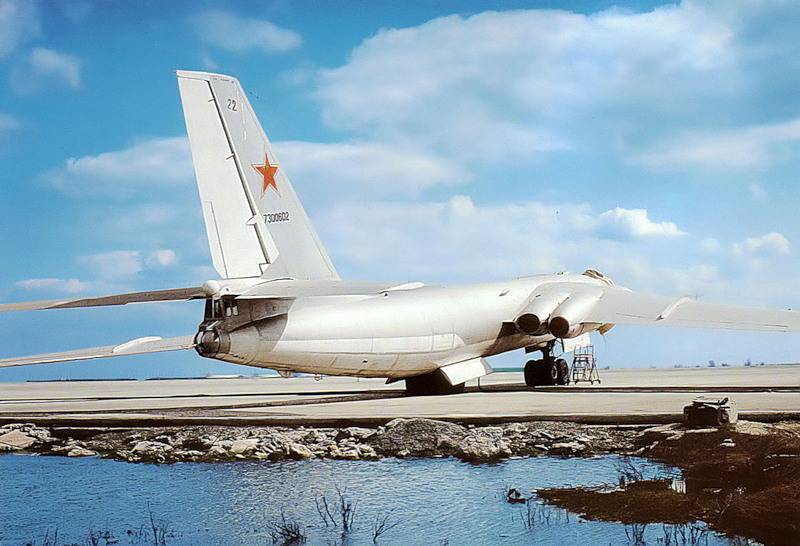

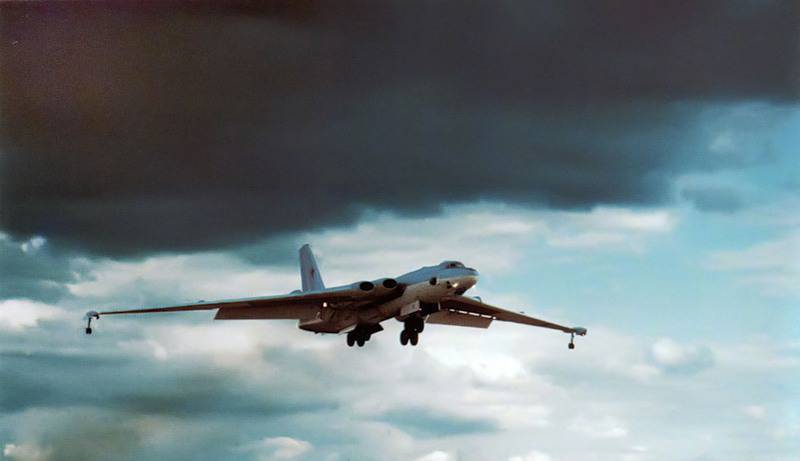
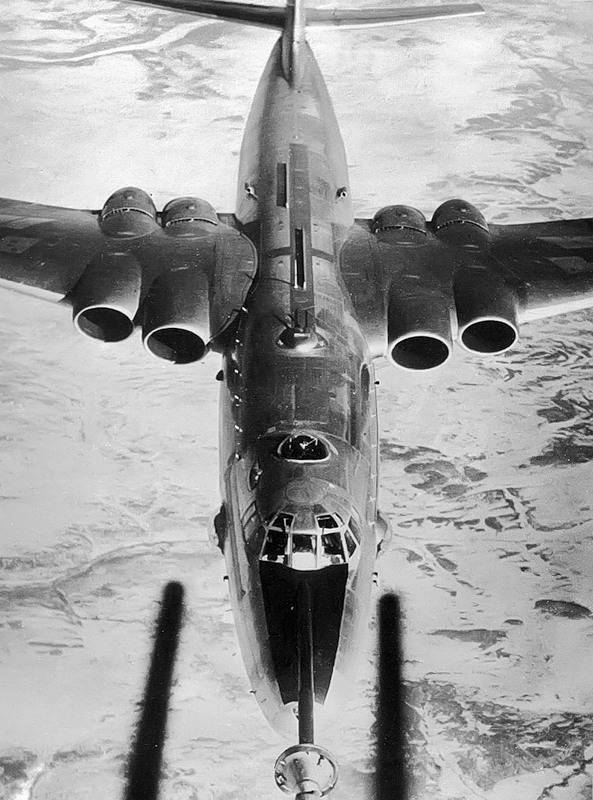
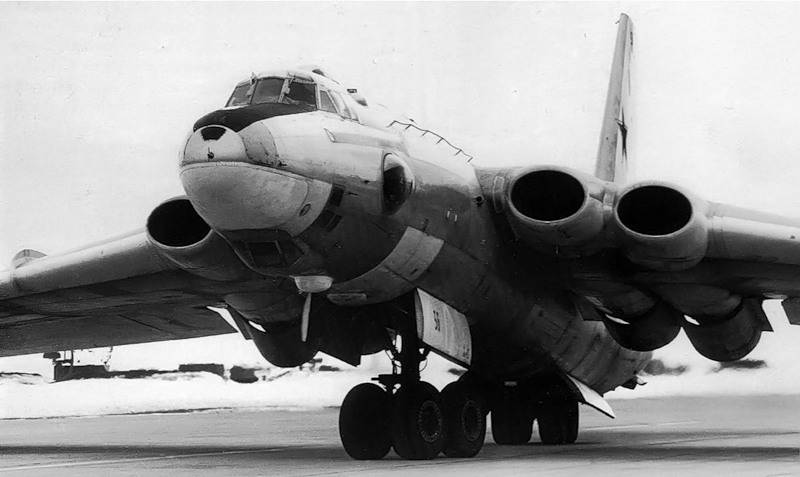
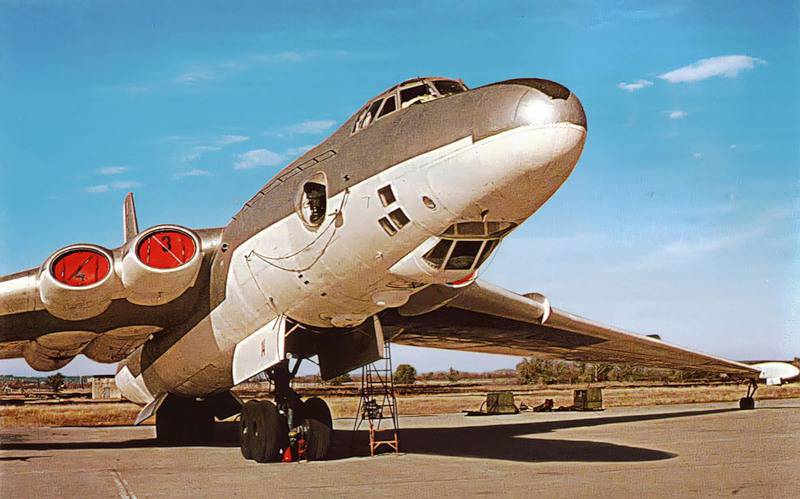
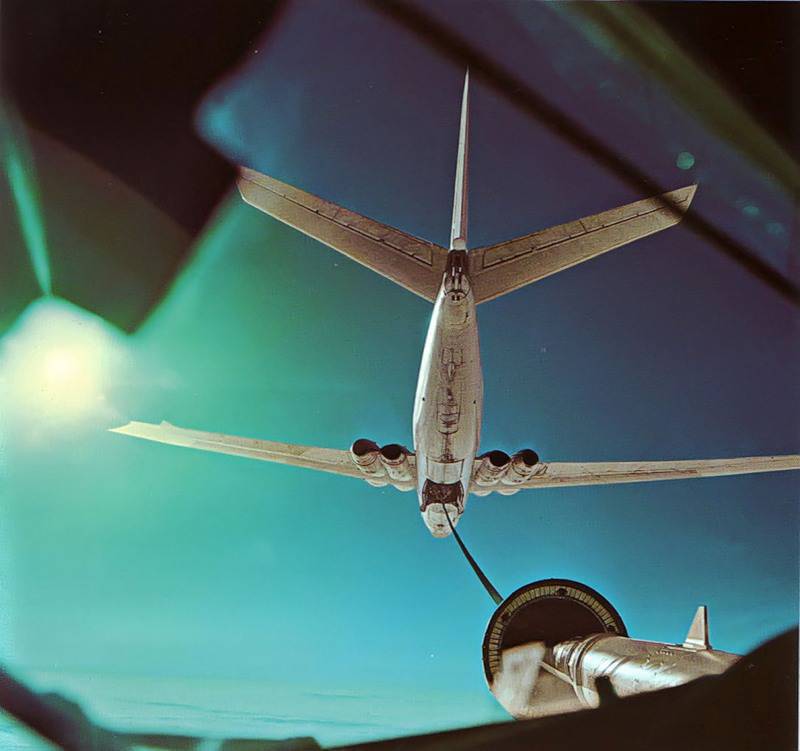
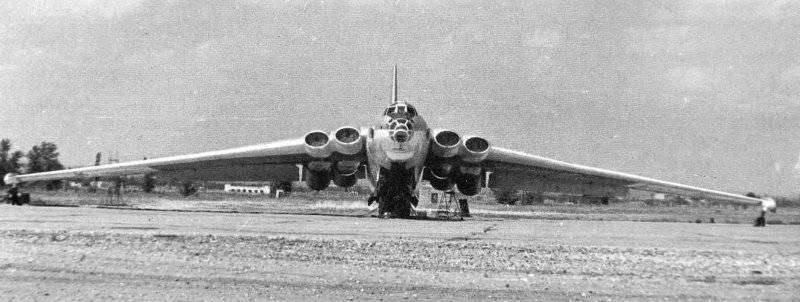
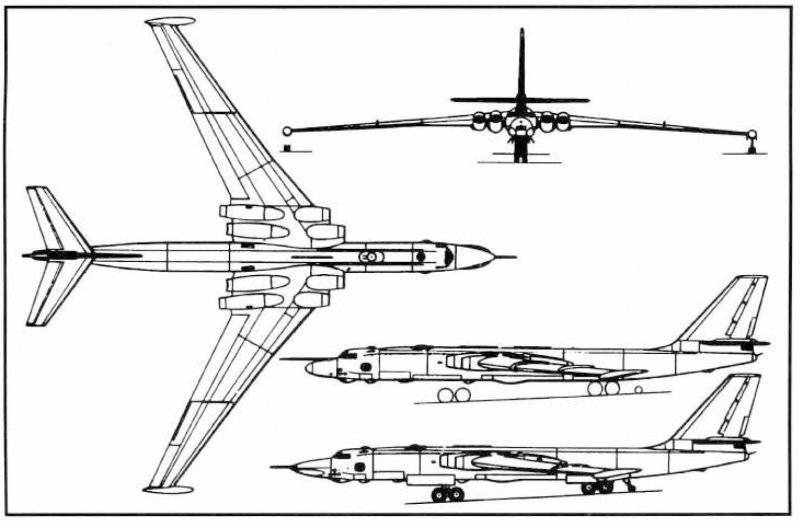
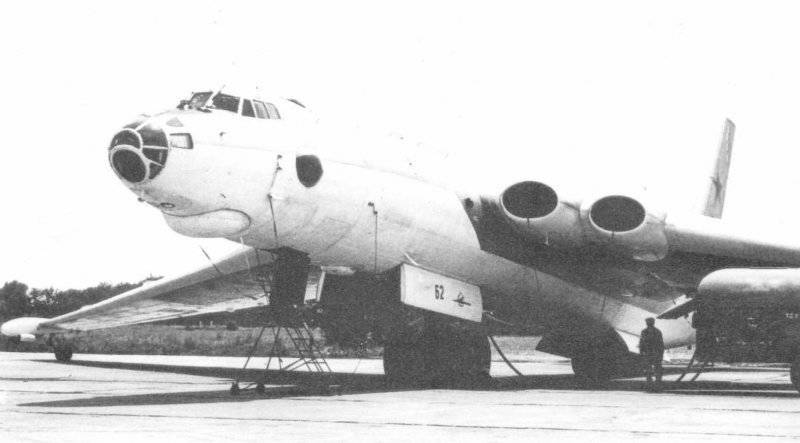
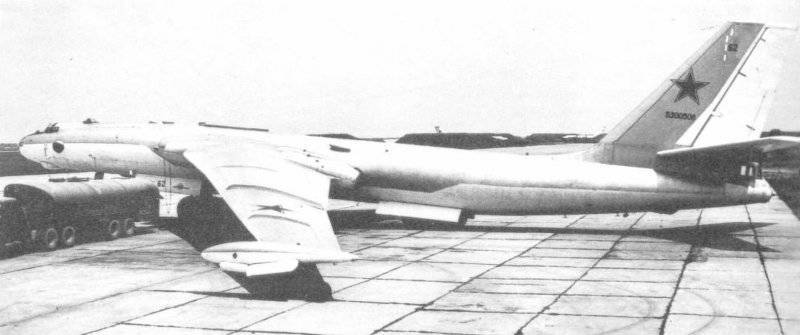
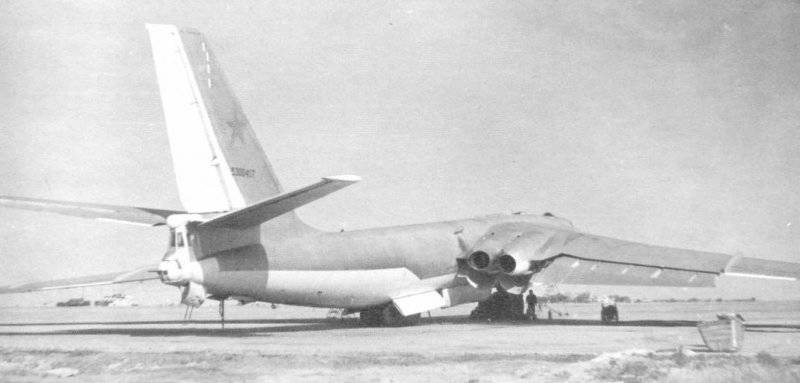
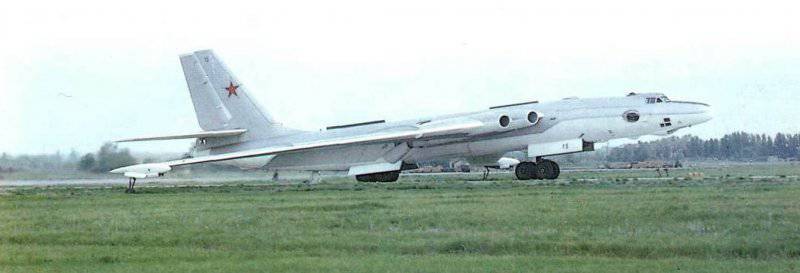
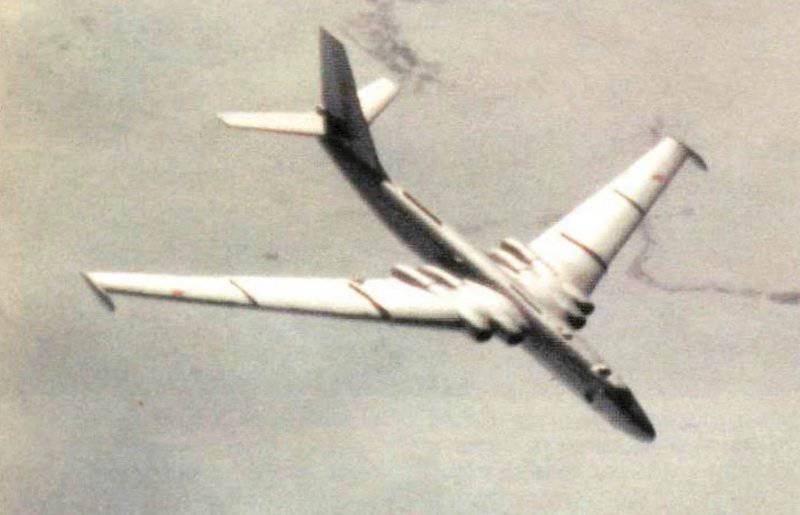
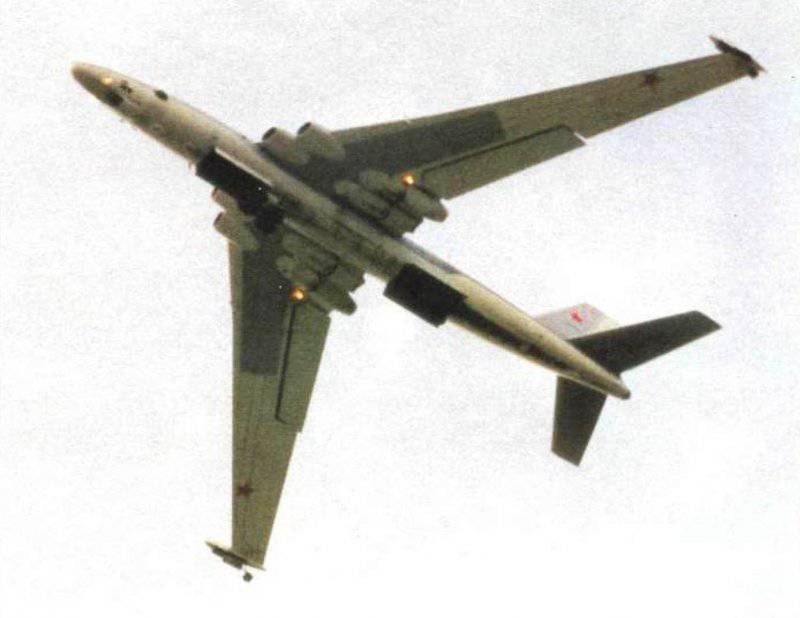

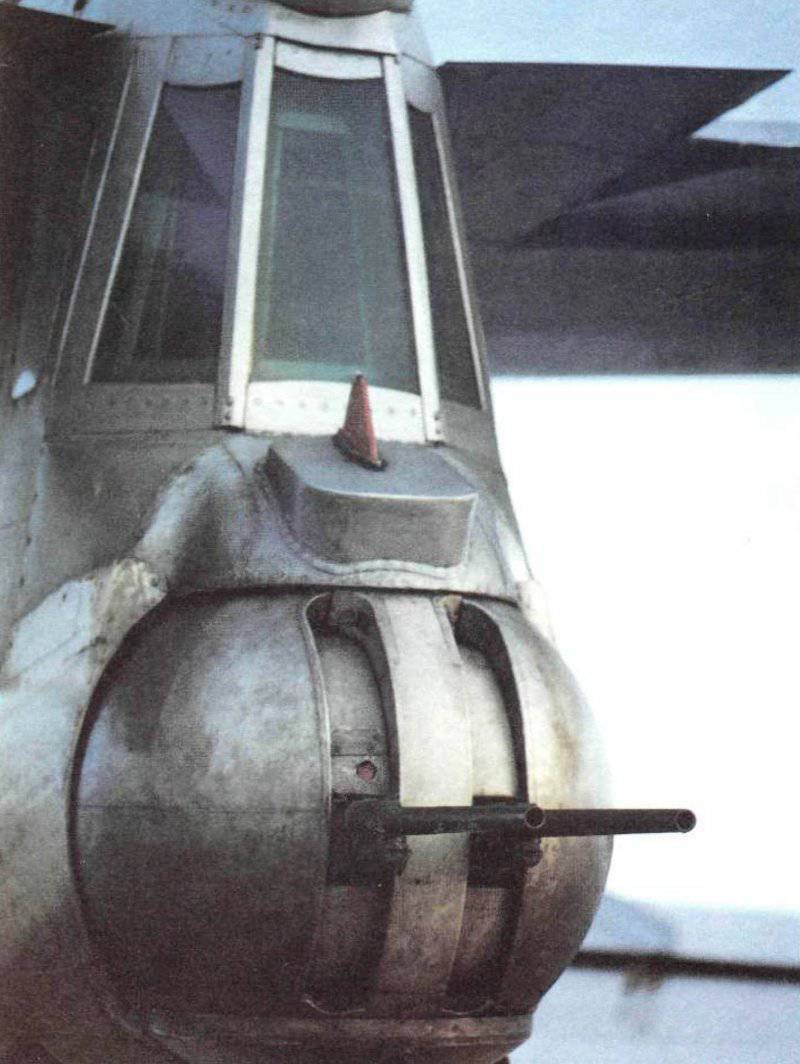
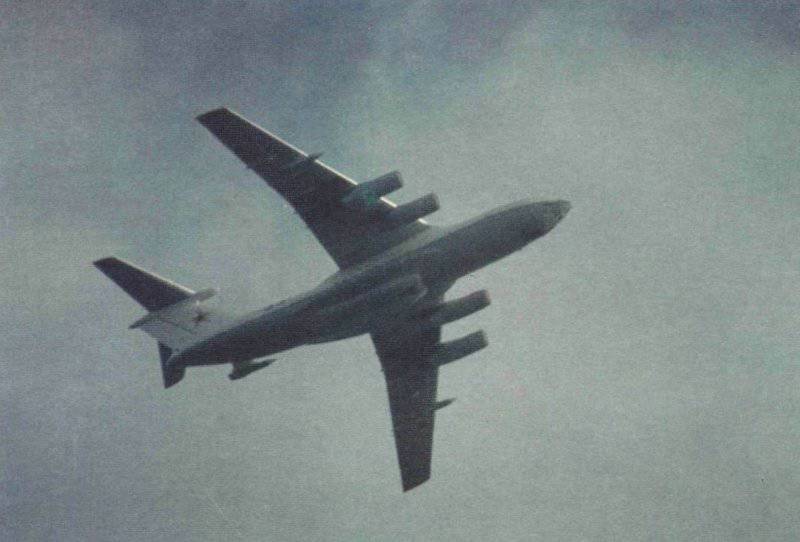
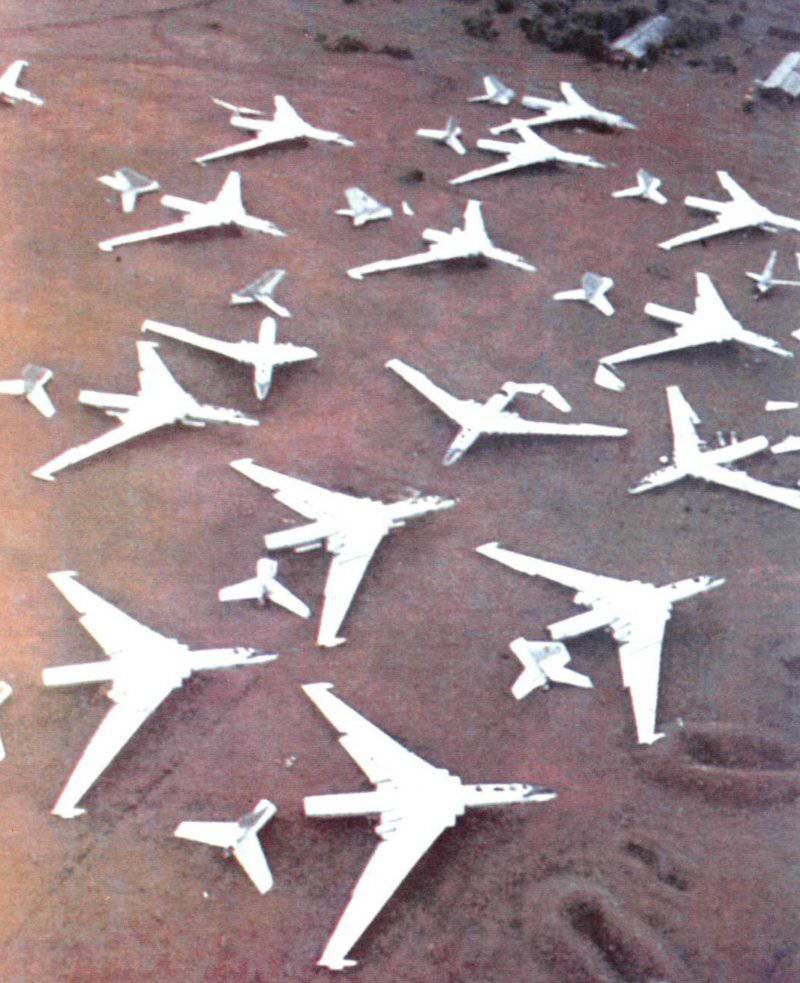
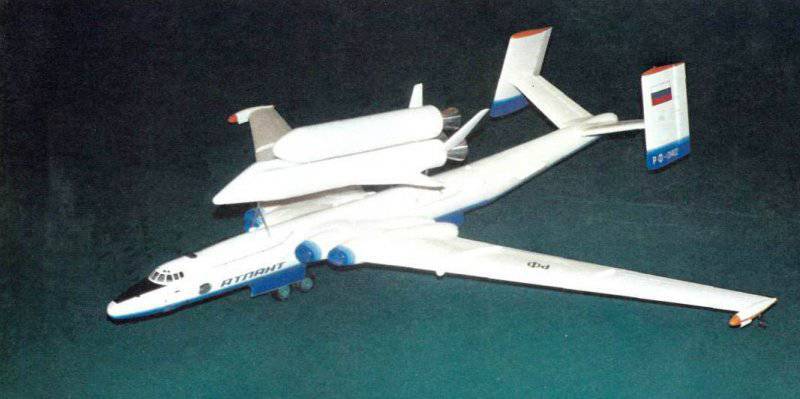
Information